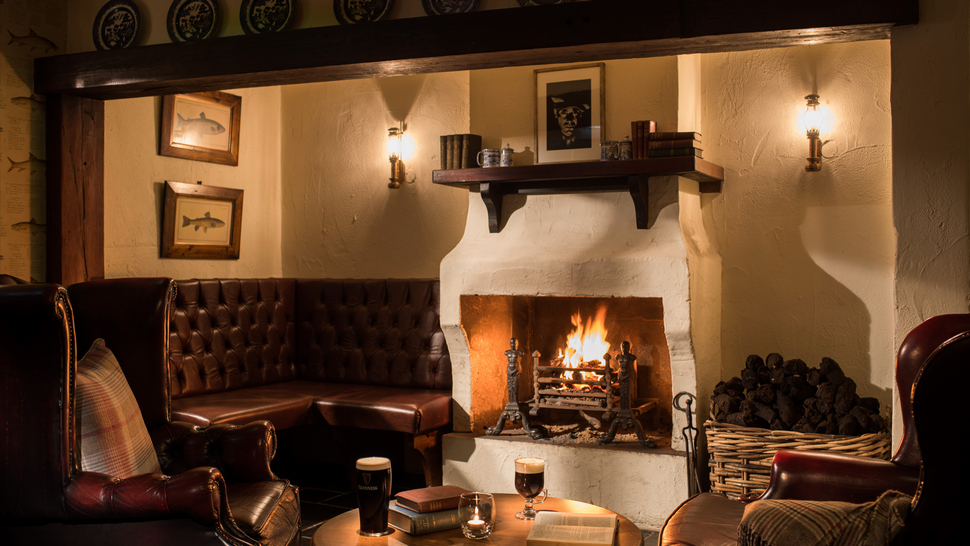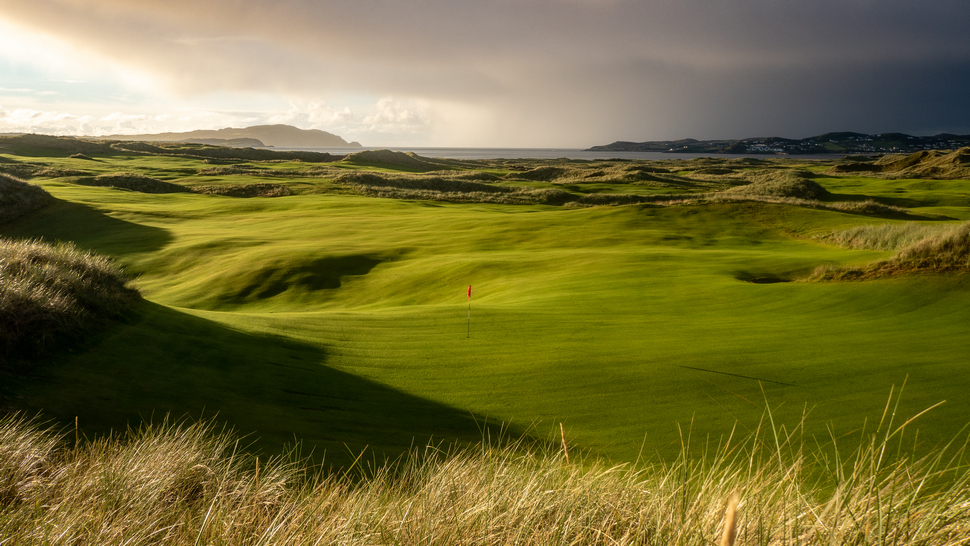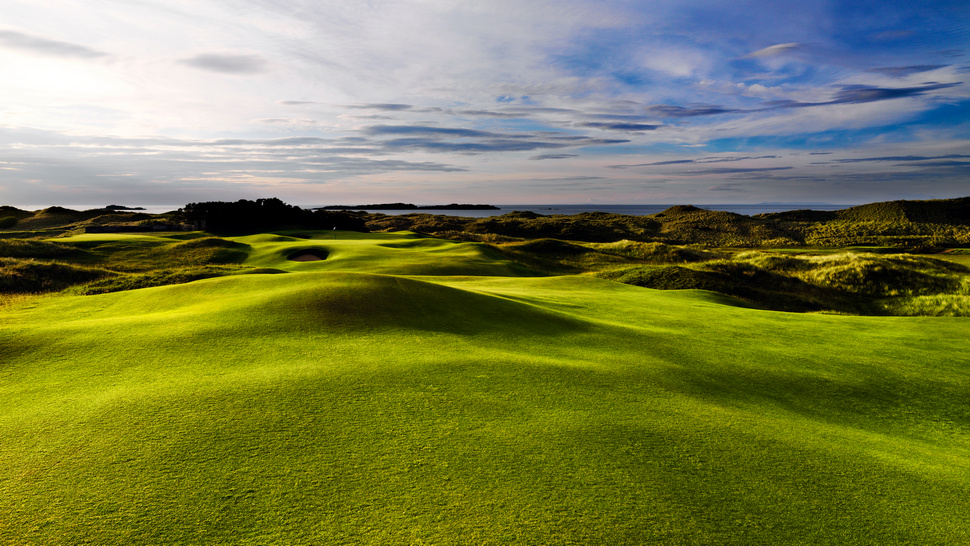October 2023 was a damp month in England. While many of the leaves were still green, and clinging on, the rain was certainly falling, and that melancholy that appears as the light starts to fade and the temperature drops is a very specific ailment for the golfing species. The parklands and heathlands start to look tired and in need of rest, but we aren’t quite ready to hang up our clubs just yet, for we still remember the times when we couldn’t play at all, bar the carpet putting routine.
And so we descend on Belfast International Airport - eight of us - in search of a final dose of great golf before autumn takes hold. Four flights from different UK cities arrive within a few minutes of each other, and we are soon en route to the north coast, whose Giant’s Causeway once connected Ireland’s shores to the western flank of Scotland - an ancient connection that makes sense by the time our return flights take off, for the golfing terrain is so similar.
Our pitstop for the night is Bushmills Inn, dating from the early 17th century. Next door, the famous distillery started making whiskey (don’t forget the “e”) in 1608, and what is now the restaurant was originally a coach-house and stables, accommodating those who travelled to explore this ancient coastline, although the buildings have also been, at times, a bicycle factory and, intriguingly, a chicken house.
In 1987, Bushmills Inn was developed into the traditional yet stylish hotel it is today, with each of its 41 rooms named after specific whiskeys, and inglenook fireplaces to warm the weary traveller, plus a gorgeous private cinema room. As you’d expect in Ireland, the hospitality is second to none, and we have barely absorbed an exceptional dinner before a wonderful breakfast spread is laid out, steeling us for the fresh air outside.
Bushmills Inn’s motto is Latin - “Quicinque curat vincit” - and a quick check via the excellent wifi reveals the translation - “Whoever cares wins”, and as I queue to check out of my room, I overhear a conversation that seems to show this caring side of the Irish psyche in action. For each night, the staff head to the Flag Room, selecting from over 300 silks in order to fly the national colours of the guest who has travelled furthest. So as we begin our short journey along the coast to the town of Portrush, the Argentine flag is flapping in the breeze - an indication of the wind that awaits us just down the road.
There is a certain romance to every Open Championship - the world’s best walking in the footsteps of generations of greats that paved the way - but while every year brings drama on the links, 2019 was one of those sporting stories that caught everyone’s attention. The Dunluce Links at Royal Portrush had been the scene of Max Faulkner’s sole major championship back in 1951, when his six stroke lead after 54 holes turned into a two stroke victory over Argentina’s Antonio Cerdá, Perhaps that’s where the flag at Bushmills had come from.
But it would take another 68 years before The Open would again descend upon this delightful town, and the 148th edition did not disappoint. As the rain whipped across the Antrim coast, Irish hero Shane Lowry would build on his joint 36 hole lead with a new course record of 63, eventually finishing six clear of Tommy Fleetwood. The Dunluce, replete with two new holes (Mackenzie & Ebert’s 7th & 8th holes) that solved the problem of a dull finish, provided a stern yet charming challenge, and before long Royal Portrush was confirmed as the venue for the 2025 Championship.
As we step from the clubhouse into a stern westerly breeze, the opening drive feels intimidating, but the course has plenty of width, and the fescue rough, while long is places, is mercifully playable. And so we weave our way across the property, perched above the same Whitesands Beach that was the stage for Game of Thrones, and between shots we stare out at The Skerries, and at distant Islay and Jura beyond. Overnight rain has not affected the firm, fine turf in the slightest, and we try and remember how to pinch the ball from such gloriously tight lies, and desperately seek to avoid the gorgeous revetted bunkers.
Harry Colt’s routing is genial, complemented by the recent changes, and the course tests every club in the bag as it moves through the large dunes, cutting back to reveal jaw-dropping views every now and then. The fifth stands out - all angles from the tee, the strategic intent of the architect unchanged by modern technology, and a horizon green is easy to love but hard to find, even with a short iron. From there, “Harry Colt’s” takes us back towards the new holes, and the central section of the course - a run of six longer holes between the seventh and twelfth - is where you must protect your score, and take few risks.
Amidst such a balanced golf course, it is hard to pick out specifics, but the fourteenth - “Causeway” - has a green complex and approach that is unforgettable, perched as a plateau above a wicked left hand bunker that our four examine more closely than seems necessary. Two holes later, the building wind is battering us on the tee of “Calamity Corner”, more than two hundred yards across what mountaineers would term a ravine, but the shot is more mouth-watering than intimidating, though two of our four hit shots that are eye-watering.
Finishing on what was the old sixteenth, the Dunluce Links is much improved from the original by the changes, and all of this recent fame and acclaim is matched in sensational conditioning. The sandy soil is true golfing pasture, but with the extended run-offs and carefully mown contours, it is hard to remember playing a course in such fine fettle. So we shake hands, and enjoy the indoor attractions of the clubhouse almost as much as the course, and on the journey out of town - heading west into Donegal, all the talk is of this most charming of golf courses.
It almost seems a shame to leave town so soon, for in this fishing and surfing hotspot there is more culture and history than in many other countries, but we are here to play golf, and so we each make private commitments to return before long, and certainly when the Open rolls in, in just twenty-one months’ time.
Soon we are hugging the Donegal coast, having crossed the border into Southern Ireland, for the next destination, Rosapenna Golf & Hotel Resort. Golf has been played here through pristine linksland since 1893, but we are here to see the latest superstar of the Irish golf market, St Patrick’s Links. Recently listed at 49 in the Golf Magazine’s new Top 100 Courses in the World ranking, the new course was designed and built by Tom Doak’s Renaissance Golf design team.
The style that is immediately evident in the Rosapenna Hotel - crisp, modern decor with ancient driftwood in the approach to the foyer and gorgeous art on the walls of the wonderful bedrooms - is reflected in the ambience of Doak’s masterpiece through the dunes south of the property. The various sets of tees are designated by their respective tee marker stones - “Granite”, “Slate”, etc., and the occasional signs to point the player in the right direction are lovingly carved from local timber.
The course begins with a first hole whose fairway is at least twice as wide as it looks from the tee, and these themes of both width - St Patrick’s is playable for all standards of golfer - and strategic architecture remain throughout the journey. Angles play a large part in the puzzle of how to get around the course, and rather than rewarding brute strength, each hole offers a variety of ways to survive and thrive.
At the second, we emerge from the wispy fescue-clad cushions of the dunes into an expansive sky, and the views across this golf course are matched by the rugged beauty of the coastline, dramatically revealed at regular intervals. The holes are individually memorable but Doak’s greatest artistic talent - that of the routing - is something to behold here. It has a rhythm that makes the time spent here flow far too quickly, testing your imagination with a wealth of architectural features that leave you grateful, regardless of your score.
As a self-confessed minimalist, Doak’s achievement here is in how much has been left untouched, sympathetic to the ecology of the land and to the exquisite contours of the co-designer, Mother Nature. Green after green has contours beyond the scope of the ordinary, yet they are generous in size and offer bailouts and options for the less courageous player. And the bunkering ought to be the subject of a PGA Tour seminar on what a “hazard” used to be, and ought to be. Here, the land is wild and craggy and the infrequent bunkers are delightfully rustic and mischievously placed.
New courses in such glorious locations are always subject to debate and controversy, but while the early inclusion of St Patrick’s Links in the higher echelons is a great and deserved achievement, the fact that it sits some 33 places behind yesterday’s marvel, the Dunluce, suggests that this is only the start of its reputation spreading around the globe.
By the time we hole out on Doak’s delightful, gentle 18th, the wind has battered us for four straight hours, but we are each enriched by the experience, and it feels as if we have been given an audience to watch the final touches being applied to some priceless canvas. St Patrick’s Links is new, but it is perhaps the finest tribute we can pay to say that it feels timeless already, and this Rosapenna resort - which has served golfers from the sumptuous menu of golf’s linksy roots for over a century - will be transformed by this latest gem.
From there, we travel east, slipping past Letterkenny to hug the coast until we reach Ballyliffin, just south of Malin Head of The Shipping Forecast fame. We will retire to the comfortable rooms of the Ballyliffin Hotel after another dose of legendary Irish hospitality in the hotel’s restaurant, where we exchange tales of our exploits at Rosapenna.
After a solid rest, no-one thinks to check the Met Éireann warning for inshore waters, but as we indulge in yet another fabulous breakfast, thermal layers and waterproofs already in evidence, the wind whistles through the courtyard, and the rain that we’d dodged in both Portrush and Rosapenna starts to fall. But we are here to experience an authentic Irish golfing experience, and so it is with delight that we arrive at Ballyliffin’s welcoming clubhouse for the final leg of this journey.
Blessed with two 18 hole Championship golf courses and a par 3 links, Ballyliffin Golf Club on the Inishowen Peninsula is one of Ireland’s great hidden gems. The Glashedy Links, named after the ancient rock that dominates the seascape off this strip of precious links, was host to the 2018 Irish Open, won by Scotland’s Russell Knox. And next year, it will host The Amateur Championship, with qualifying held on the Old Links beforehand.
It is the Old course we play this morning, our trouser legs flapping and our hats dripping as we battle against the breeze. The course remains firm, though, and as we progress through the front nine, hole after hole has charm and intrigue. Perhaps the signature hole, “Tank”, deserves to stand out as it is such a unique design, an elevated green perched between two intimidating dunes, but in truth the Old Course has no weak holes, and it is through this consistency that its reputation is built.

Related: West Coast Swing
By the time we arrive back near the clubhouse at the 9th, three quarters of our travelling party are too cold and wet, and retreat to the showers to escape the persistent battering from the elements. But two of us, though soaked to the skin already, have seen enough of Ballyliffin to be in love with it, and so we whip round the back nine in under an hour, all the time with one eye on the warm-looking respite of the 19th hole.
From the tenth, the course seems to build on the strong foundations going out, and as we approach towards the southerly end of the property, hole after hole blows us away. We pass through rumpled fairways to arrive at the tough par 3 twelfth, from where the thirteenth draws us into the far corner of Ballyliffin’s majestic canvas, before a staggering long hole hugs the coast as it travels towards a unique green complex, guarded on the left by a grassy knoll, on the right by a deep, mown abyss.
On the sixteenth, we narrowly avoid a bunker reminiscent of the greenside one at the Road Hole, and enjoy a short penultimate hole before the par five eighteenth delivers us safely back to the clubhouse. Before long, we are in the bar, nursing hot soup with the local ramblers, and watching the weather front move across this panoramic landscape before us.
To descend on a club fresh from the world-famous marvels of Royal Portrush and St Patrick’s Links seems unfair in a way; a billing that few could live up to. But despite the wind and the rain, despite the fatigue in our legs and the drenched clothing that we press into our luggage - despite all that, Ballyliffin Old is still a delight, and we leave vowing to come back on a drier day, and sample the Glashedy next time, too.
For there is something in Ballyliffin’s DNA that screams simplicity - in design, in the fine presentation, in the bunkering and in the simple, charming service of its staff that seems to sum up golfing in Ireland as well as either of the other courses we’ve been lucky enough to play. This place is a roller-coaster ride in the shadow of the nearby mountains, and should be on every purist’s wishlist.
And so our little tour is over, and in the effortless transit through Belfast airport we prepare to resume normal life back in our own pockets of the mainland. But somewhere in my psyche, stored away for future reference, is this feeling of golfing in the wild landscapes of the Emerald Isle, of breathing in the sea air of this precipitous northern coastline, and of exploring golf as it is meant to be played on some of the world’s finest golf links. It was only three days, but the memories will last a lifetime.
Find out more about the wealth of golfing finery in Ireland via Tourism Ireland’s golf portal, here: www.ireland.com/golf
Read more about Royal Portrush and St Patrick’s Links via Richard Pennell’s pitchmarks blog, here and here respectively.








